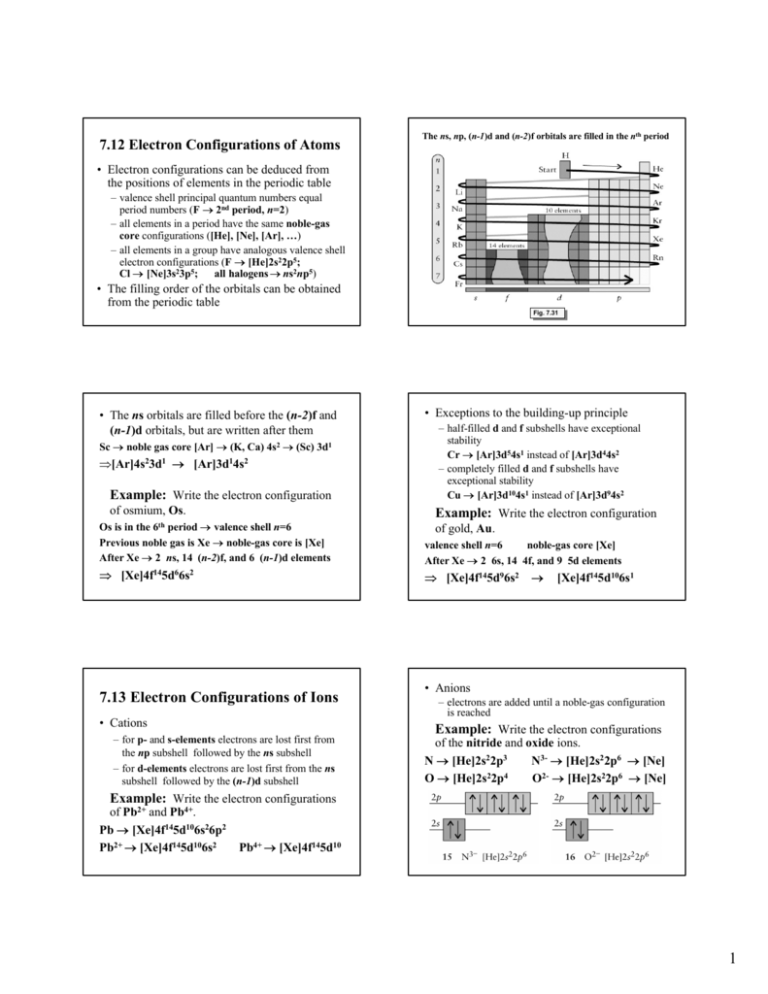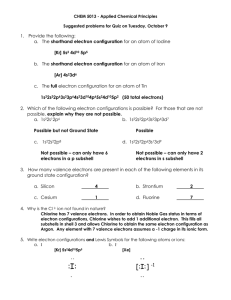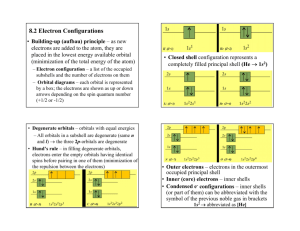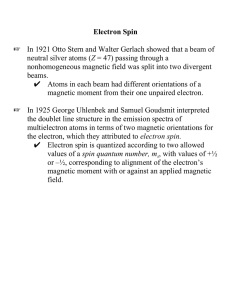7.13 Electron Configurations of Ions
advertisement

7.12 Electron Configurations of Atoms The ns, np, (n-1)d and (n-2)f orbitals are filled in the nth period • Electron configurations can be deduced from the positions of elements in the periodic table – valence shell principal quantum numbers equal period numbers (F → 2nd period, n=2) – all elements in a period have the same noble-gas core configurations ([He], [Ne], [Ar], …) – all elements in a group have analogous valence shell electron configurations (F → [He]2s22p5; Cl → [Ne]3s23p5; all halogens → ns2np5) • The filling order of the orbitals can be obtained from the periodic table Fig. 7.31 • The ns orbitals are filled before the (n-2)f and (n-1)d orbitals, but are written after them Sc → noble gas core [Ar] → (K, Ca) 4s2 → (Sc) 3d1 ⇒[Ar]4s23d1 → [Ar]3d14s2 Example: Write the electron configuration of osmium, Os. Os is in the 6th period → valence shell n=6 Previous noble gas is Xe → noble-gas core is [Xe] After Xe → 2 ns, 14 (n-2)f, and 6 (n-1)d elements ⇒ [Xe]4f145d66s2 • Exceptions to the building-up principle – half-filled d and f subshells have exceptional stability Cr → [Ar]3d54s1 instead of [Ar]3d44s2 – completely filled d and f subshells have exceptional stability Cu → [Ar]3d104s1 instead of [Ar]3d94s2 Example: Write the electron configuration of gold, Au. valence shell n=6 noble-gas core [Xe] After Xe → 2 6s, 14 4f, and 9 5d elements ⇒ [Xe]4f145d96s2 → 7.13 Electron Configurations of Ions • Cations – for p- and s-elements electrons are lost first from the np subshell followed by the ns subshell – for d-elements electrons are lost first from the ns subshell followed by the (n-1)d subshell [Xe]4f145d106s1 • Anions – electrons are added until a noble-gas configuration is reached Example: Write the electron configurations of the nitride and oxide ions. N → [He]2s22p3 N3- → [He]2s22p6 → [Ne] O → [He]2s22p4 O2- → [He]2s22p6 → [Ne] Example: Write the electron configurations of Pb2+ and Pb4+. Pb → [Xe]4f145d106s26p2 Pb2+ → [Xe]4f145d106s2 Pb4+ → [Xe]4f145d10 1 7.14 Electronic Structure and the Periodic Table • The table is divided into s, p, d, and f blocks named by the last occupied subshell being filled • Valence electrons – electrons in the highest occupied principal shell and in partially filled subshells of lower principal shells • Main groups – s and p elements – group 1 ns1, group 2 ns2, group 13 ns2np1, ..., group 18 ns2np6 • Secondary groups – d elements – group 3 (n-1)d1ns2, …, group 12 (n-1)d10ns2 The Periodicity of Atomic Properties • The number of valence electrons equals the group # (group # - 10 for p-elements) Example: Write the valence electron configurations of groups 7 and 15. Group 7 → 7 valence electrons, d-elements 2 s-electrons and 5 d-electrons ⇒ (n-1)d5ns2 Group 15 → 15-10=5 valence electrons, p-elements 2 s-electrons and 3 p-electrons ⇒ ns2np3 • Atomic radii increase down a group and decrease from left to right across a period 7.15 Atomic Radius • Half of the distance between the centers of two neighboring atoms – metals - in the solid phase – nonmetals - in molecules (covalent radius) Fig. 7.34 • Down a group – the principal quantum number increases ⇒ orbitals and electron clouds become larger • Across a period – the nuclear charge increases and the new electrons enter the same principal shell (do not shield each other effectively) ⇒ the effective nuclear charge increases ⇒ draws the electrons closer to the nucleus Example: Compare the sizes of Ge, Sn and Se. Sn is below Ge ⇒ Sn>Ge Ge is to the left of Se ⇒ Ge>Se 2







